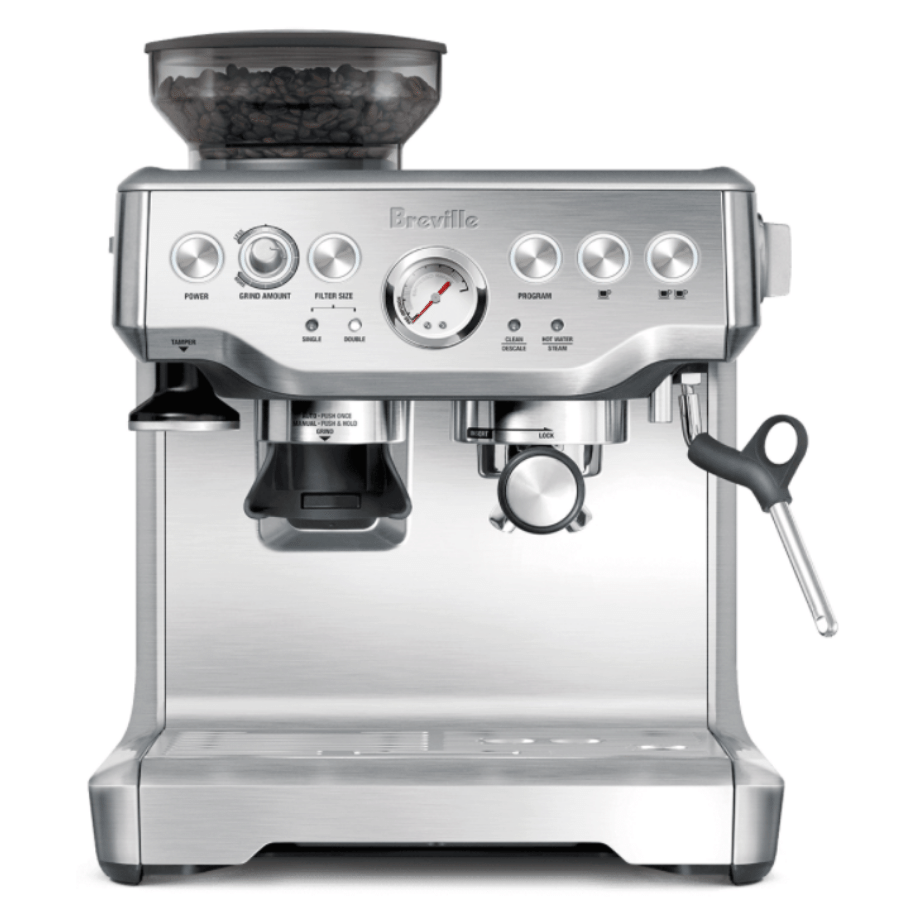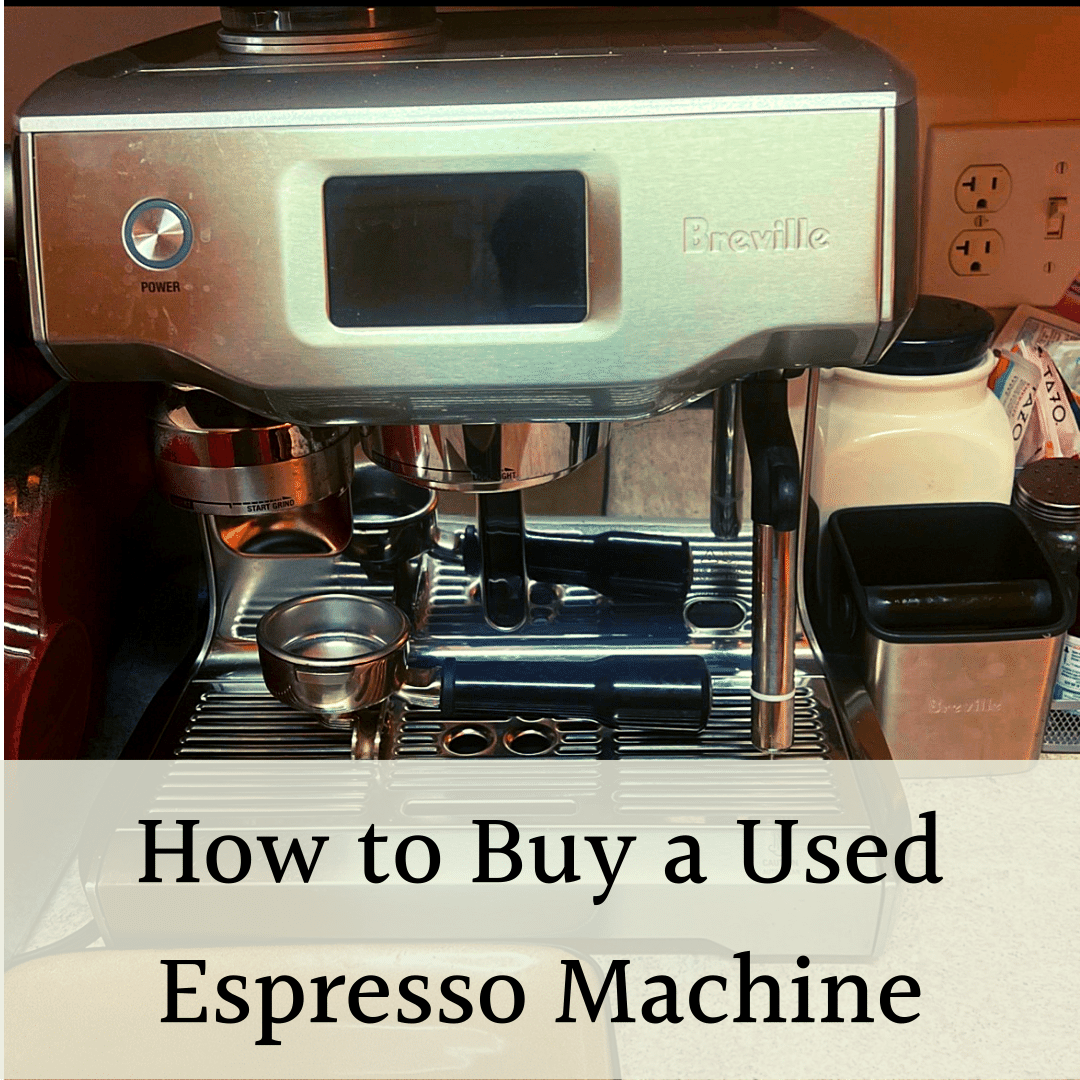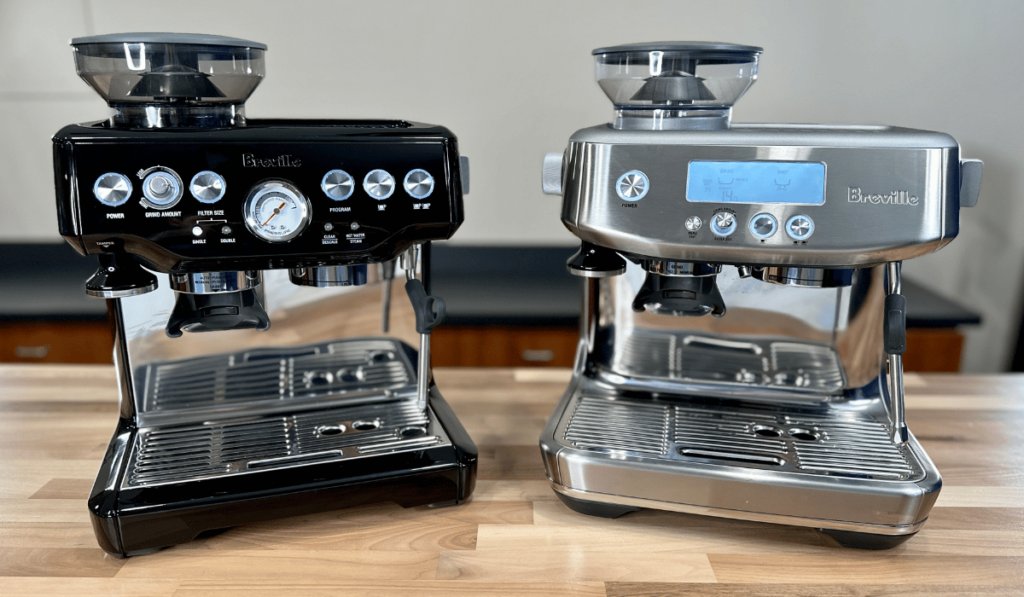
It’s time for a Breville showdown between the two popular Barista models: the Barista Pro and Barista Express. For years, the Breville Barista Express was the flagship model and a bestseller for a reason. Then, Breville launched the Barista Pro at a premium despite a very similar design. So, how do you compare the Breville Barista Pro vs. Barista Express?
I’ve used both espresso machines, and the Breville Barista Pro is the better choice. The Thermojet heating system, LCD display, and better grind settings make the Pro the clear choice over the Express, even at the premium price.
I’ll explain the features in detail so you’ll understand where and why the Breville Barista Pro is better. But, I’ll also talk about the strength of the Breville Barista Express. Get ready for a visual treat with photos and comparison tables that make understanding the differences a breeze.
Feature Breakdown
The main differences between the Breville Barista Express vs. Pro are the heating system, grinder, and display. The Breville Barista Pro is better in all three categories.

I’ll breakdown all of these features and discuss how they translate into the value for the price.
Internal Workings & Espresso Performance
One of the most important differences between the Breville Barista Express vs. Barista Pro is the heating system. Breville incorporated its improved ThermoJet heating system into the Pro model, which is a significant upgrade to the older thermocoil on the Barista Express.
I’m a coffee nerd at heart, so I can talk about the differences between thermal blocks, boilers, and heat exchangers for a while. Both of the Breville Barista models use a thermocoil system.
Thermocoils (or thermoblocks) are aluminum blocks with intricate stainless steel piping inside. Water enters one end, moves through the piping system within the heated block, and comes out hot on the other end. Thermocoils are common on home espresso machines, but the difference is how fast and consistently they heat water. That’s where the Breville technology comes into play.
The newer Thermojet uses a very thin film as the heating element where the piping is tiny. That means the heat transfers almost instantly to the water, which leads to an impressive 3-second heat up time. That all means you don’t have to wait for the machine to heat up in the morning, nor do you have to wait between brewing coffee and steaming milk.
You can see Breville’s graphics of each system to get an idea of the ThermoJet:
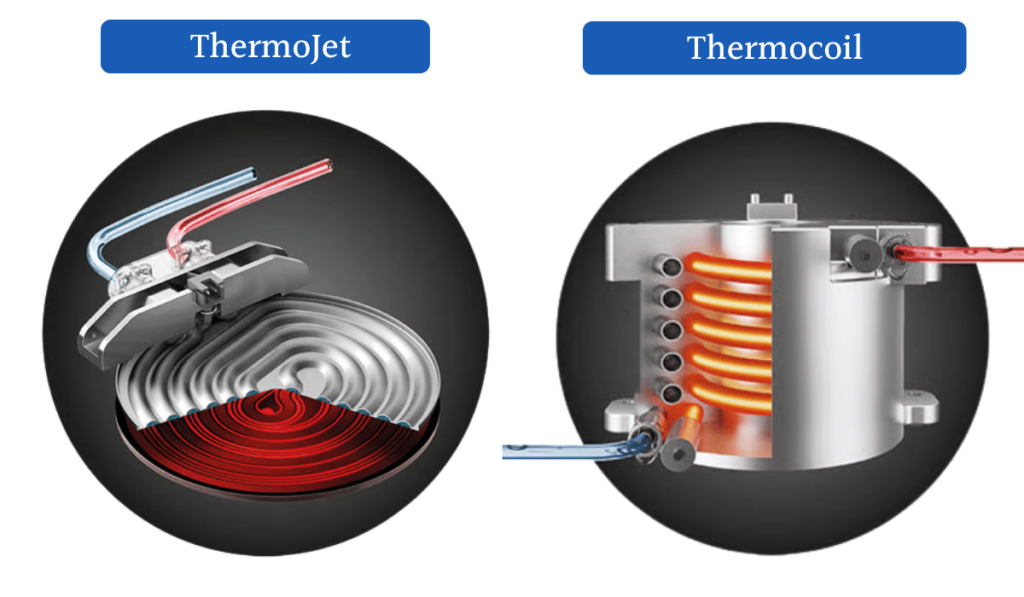
The Barista Express uses a thermocoil system that heats in about 30 seconds. That time beats most other espresso machines, but it’s an extra 30 seconds every morning without espresso.
What’s equally important is that ThermoJet has a more consistent water temperature. The thin-film substrate on the ThermoJet has more precise temperature control. Both machines have a proportional–integral–derivative (PID) controller, which is an added temperature control system, but the Barista Pro’s newer design gives enhanced control.
Temperature control IS really important. Good espresso is all about consistent extraction and consistent extraction is about consistent temperature control.
I notice this when using each machine side-by-side. The Barista Pro delivers more consistent espresso, while the Barista Express shots can be sour and turn bitter over time. To me, that reflects an uneven temperature.
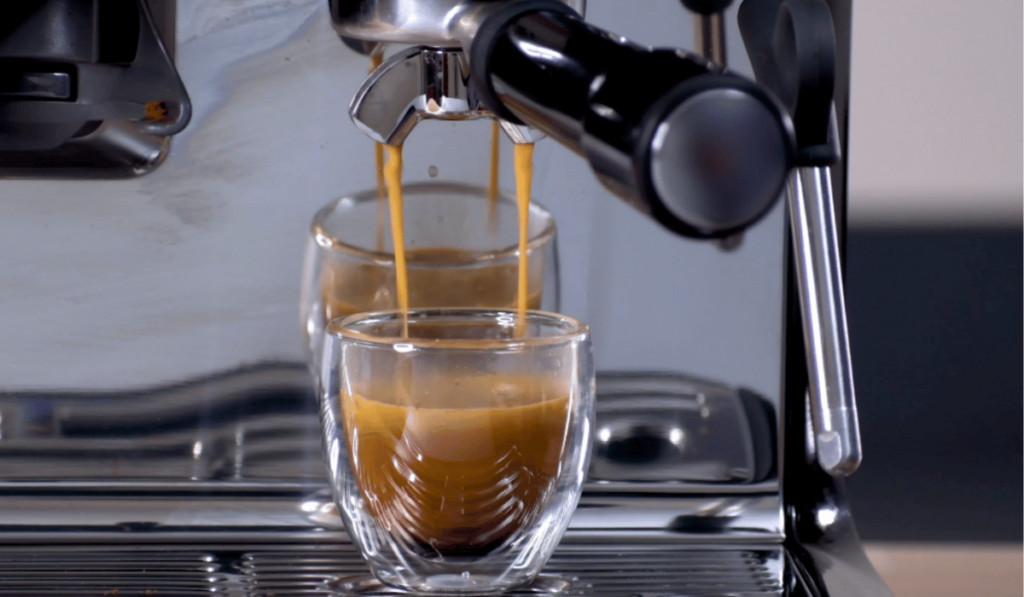
After more testing, I’ve also learned the Breville Barista Express runs at a much higher pressure than the Barista Pro. The Express runs at 14-15 bars, while the Pro peaks at 10 bars. The pressure is an under-appreciated tweak that Breville made to newer models.
The lower pressure means espresso flows more steadily on the Pro, which also leads to a smoother and more balanced taste. I modified my Barista Express to reduce pressure, which helped. That said, I wouldn’t recommend newbies attempt this. You’re better off going with the newer Barista Pro, which still tastes better.
Seattle Coffee Gear said it well in their testing:
The design principals between the two heating elements are similar, but the Pro’s heating is just… better.
-Seattle Coffee Gear
One downside of the ThermoJet system is you have to run a blank shot (that is, just water) to heat the system. The ThermoJet is too efficient with a three-second start time. Actually, you should run water through both machines to properly pre-heat it.
Overall, the key difference is the speed and control of water temperature. The clear winner is the Breville Barista Pro.
Grinder
The grinder is another area where the Barista Pro espresso machine is the clear winner. Both machines include an integrated conical burr grinder, which has the same stainless steel conical burr. However, the Breville Barista Pro espresso machine gives you better control with 30 settings vs. 16 for the Express.
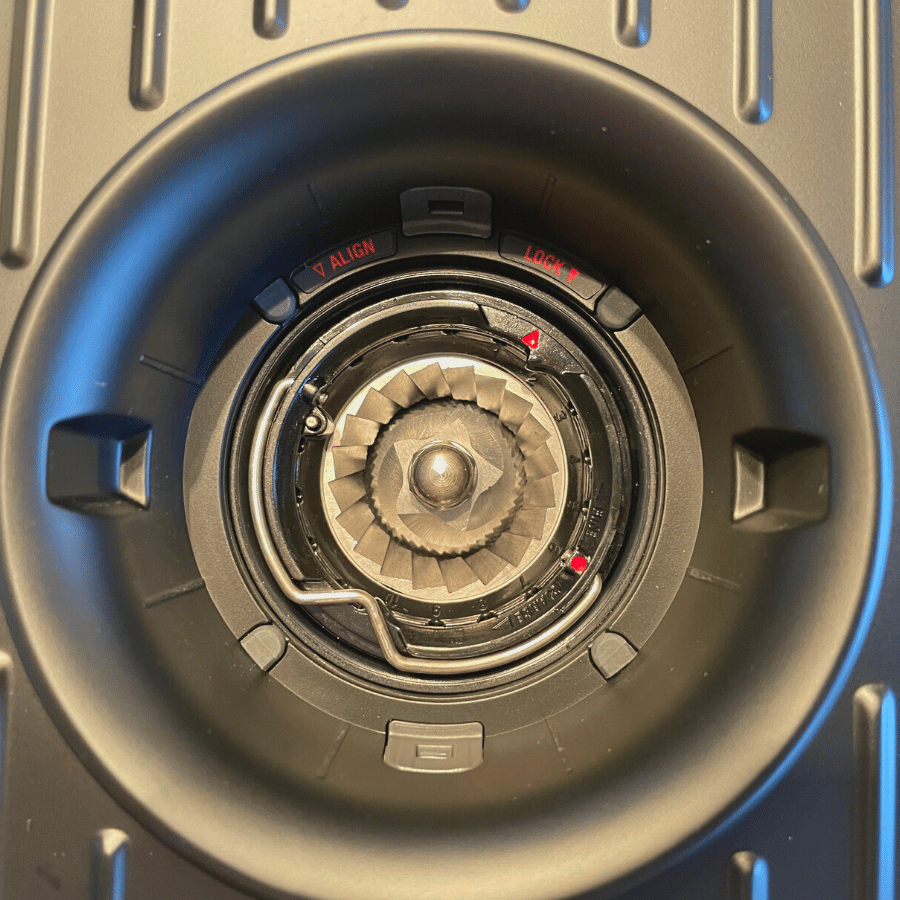
Grind size is a critical factor in making great espresso. Too fine, and your espresso shot comes out cloudly. Too coarse, and your shot ends up too weak.
This is where the 30 steps on the Pro come in play against the 16 on the Express. More settings give you a better chance of getting the exact grind size you want.
Good espresso is all about “dialing it in” to get the best taste. Every bag of beans needs to be brewed slightly differently. Differences in the batch of beans, the age of the beans, or even the weather can call for different grind sizes. The Pro gets extra precision here.
Another point for the Breville Barista Pro is the “Pause Grind” function. During the grind, push in the portafilter to pause grinding. That allows you to distribute the coffee grounds with a few taps before finishing up. You avoid the big mountain of grounds that inevitably spills all over when you take out the portafilter.

That said, the Breville Barista Express still gives you good flexibility in grinding your coffee beans. The 16 grind levels cover most of the options you’d want for your optimal espresso extraction. It’s just not as exact, and that means the espresso won’t be quite as pristine.
All in all, the Breville Barista Pro comes out on top. It offers a more precise range of grind settings, which lets you dial in the ideal espresso. The Breville Pro also lets you pause grinding, a nice convenience.
Design, Display, Ease of Use
The two Breville machines come out about equal in terms of design, but the display and ease of use are where they differ.
Design
Both the Breville Barista Pro and the Barista Express are visually appealing. They both have nice, rounded edges and sleek designs. The Barista Pro comes in more colors, and I recommend the Truffle Black or Damson Blue for the Pro. Meanwhile, the black doesn’t stand out from the stainless steel on the Express.

The specs are pretty similar with dimensions of 12.5″ x 13.8″ x 15.9″ (WxHxD), bean hopper capacity of 1/2 pound, and water reservoir of 67 oz for the two machines.
Each machine also benefits from excellent tooling and design from a sturdiness standpoint. They come in at about 20 pounds each, given the heavy steel in the body. There’s certainly enough heft to support the high-quality internal components.
Both models have one design feature that I especially like: a removable water reservoir. You can take out that extra step of filling up a pitcher and then pouring it into the tank. The Barista Pro also has a low water sensor, which is a nice addition that prevents the frustrating experience of pouring a half shot.
Both machines have the same accessories:
- Portafilter with dual spout
- Two pressurized baskets: one-cup and two-cup
- Two non-pressurized baskets: one-cup and two-cup
- Milk jug
- Tamper
- Cleaning disc, cleaning kit, and tool for
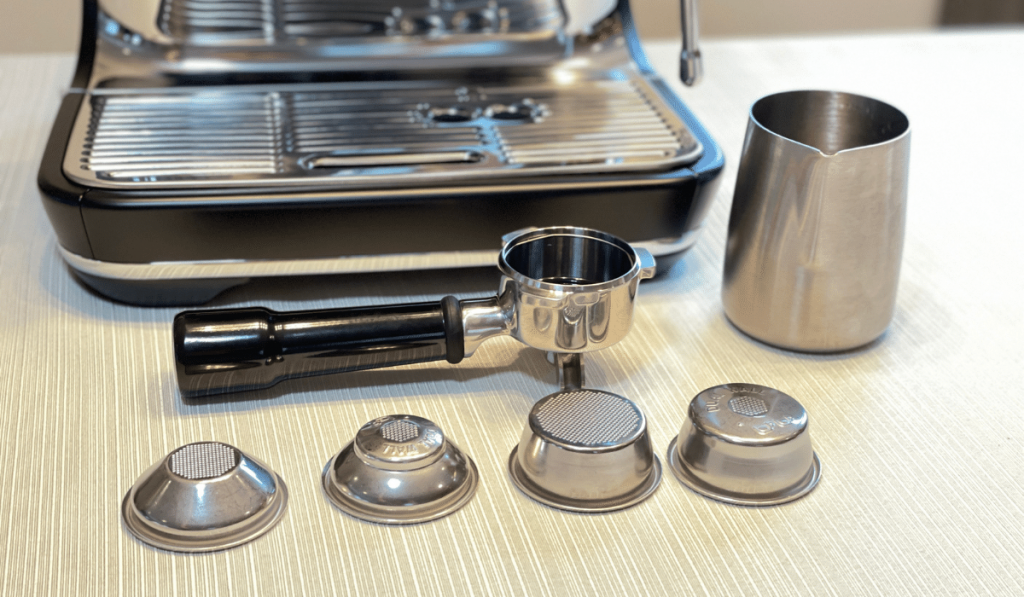
This is pretty much a tie as the machines are almost identical. Overall, both options will be aesthetically pleasing in the kitchen. Make sure your Express model has a removable water tank.
Display and Ease of Use
Both machines have automatic settings with one-touch buttons to make a single or double shot of espresso. The differences come in how easy the interface and programming are to use.
The Barista Pro has an LCD digital display and a digital interface, while the Breville Barista Express uses a manual display. The information you get from each display is also slightly different. The Pro’s display is better overall because it makes it easier to program your shot for the perfect espresso.
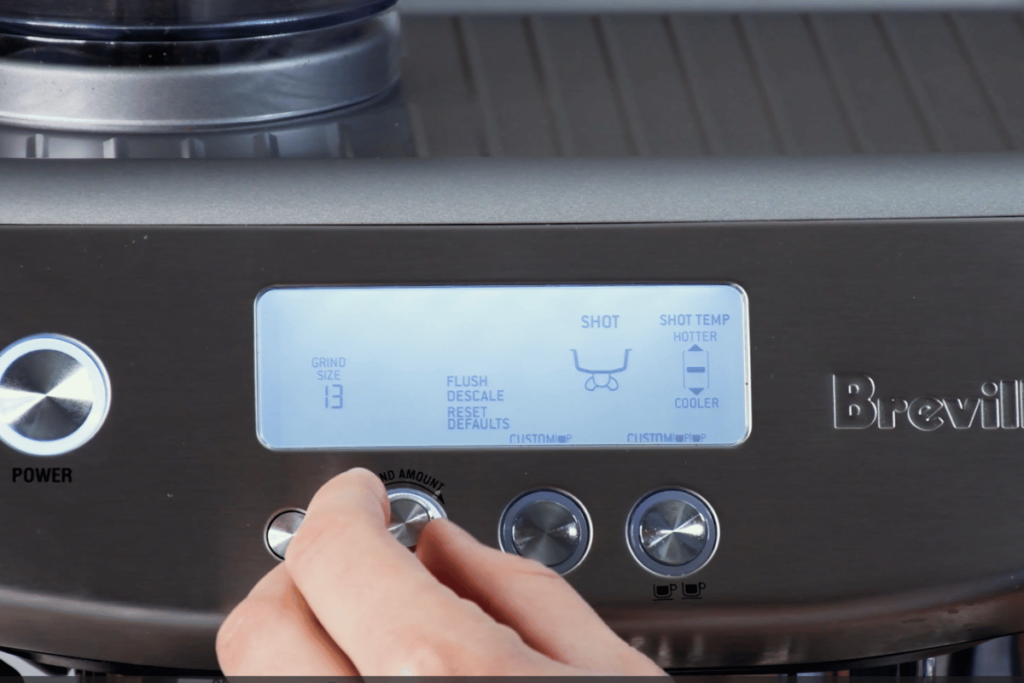
The LCD interface on the Breville Barista Pro is easier to make sense of, especially if you’re an espresso beginner. You hit the menu button, then use the dial and the shot buttons to make changes. The combination of a dial to navigate left and right and buttons is intuitive.
On the Barista Pro, you can change the shot volume, water temperature, and pre-infusion time. On the Express, you can change shot volume and water temperature, but not the pre-infusion time. The pre-infusion is the initial low-pressure stage, which wets the grounds and makes the puck more even for a better extraction at the full nine bars of pressure.
One easy espresso hack is to program a longer pre-infusion time, which reduces channeling. You can do that manually on the Barista Express, but cannot program it.
The Pro’s LCD display is easier to use. Move the dial to the right, hit the shot button, and use the dial to easily adjust the water temperature up or down. You can see the temperature setting every time the machine is on.
The Barista Express has an analog pressure gauge and a set of buttons that is a little more traditional.
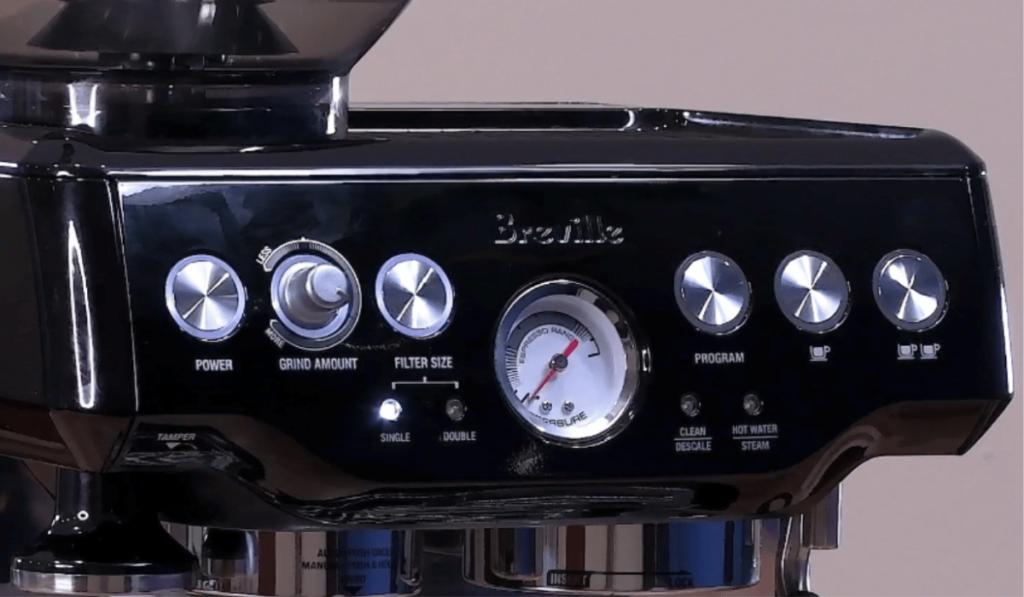
On the Express, you can still change almost all the same settings, except for programming pre-infusion time. The problem is I had to keep referring to the manual to remember how to change those settings.
The Express has an analog pressure gauge, which is stylish. It’s fun to watch as you make espresso, and you can guide your grind size based on whether the dial is at the high end (too fine) or below the “espresso range” (too coarse). However, you can derive this same information from the shot timer on the Pro, where >35 seconds means too fine and <20 seconds means too fine.
The dedicated hot water spout is another design improvement on the Breville Barista Pro vs Express. The Pro has an angled spout that dispenses hot water right under the portafilter, while the Express hot water outlet is a little to the right and dispenses straight down, slightly behind the portafilter. It’s easier to make Americanos with the Pro.
All in all, the Pro’s LCD display beats the analog display on the Breville Express. For both machines, you can program multiple settings for the best shot.
Steam Wand and Milk Frothing
After the perfect shot, milk steaming performance is the second key issue for any espresso machine. This is another area where the Barista Pro takes the win. The new ThermoJet system speeds up steaming milk as it does for brewing perfect espresso shots. You can see this in our video:
In addition, the Pro features a four-hole steam wand configuration, compared to the single-hole wand on the Barista Express. The four-hole configuration on Barista Pro espresso machines delivers more steam throughput than the single hole. You can steam milk in about 45 seconds on the Pro versus 90 seconds for the Express.
The four-hole steam wand aerates milk faster to create a microfoam for latte art. The single hole on the Express still makes microfoam, but it takes longer.
I switched the steam hole tips, and the Pro was still comfortably faster. That is another signal that the Thermojet is a better heating system.
Both machines feature manual milk wand functions, which means you will have to learn a bit about the quirks and tricks to froth milk just right, but the four-hole setup makes it a lot faster.
Price and Value
Both machines sit within the mid-range of Breville’s lineup – not cheap, but much less than high-end machines.
When it comes to price by itself, the Barista Express wins, simply because it’s the cheaper machine. But if we’re talking about value, then the Barista Pro takes the title, because you get a lot more for a modestly higher price.
When the Barista Pro first came out in 2019, the price difference was much steeper, but I would argue that even at the higher price, the Pro is worth it for its enhanced features. An espresso machine is all about good espresso, and the ThermoJet and finer grind settings win out here.
The Barista Express is a solid machine if you want to save money. The thermocoil heating system puts it above other machines in the industry.
For me, however, the Pro wins out in the value department. The way I look at it, I’m happy to spend extra on a coffee machine that I’ll be using for years to come. That morning espresso is the best part of the day (for me, at least), and I want it to be excellent. Better quality and easier use with the Barista Pro is well worth the price.
The Winner: Breville Barista Pro
The Breville Barista Pro is the better espresso machine, compared to the Breville Barista Express. The Breville Pro wins out because you can make better espresso with more ease at a reasonable price.
The better heating system, additional control over grind size, and programming on the Pro edges out the Barista Express. You’ll also get a faster startup time and milk frothing too.
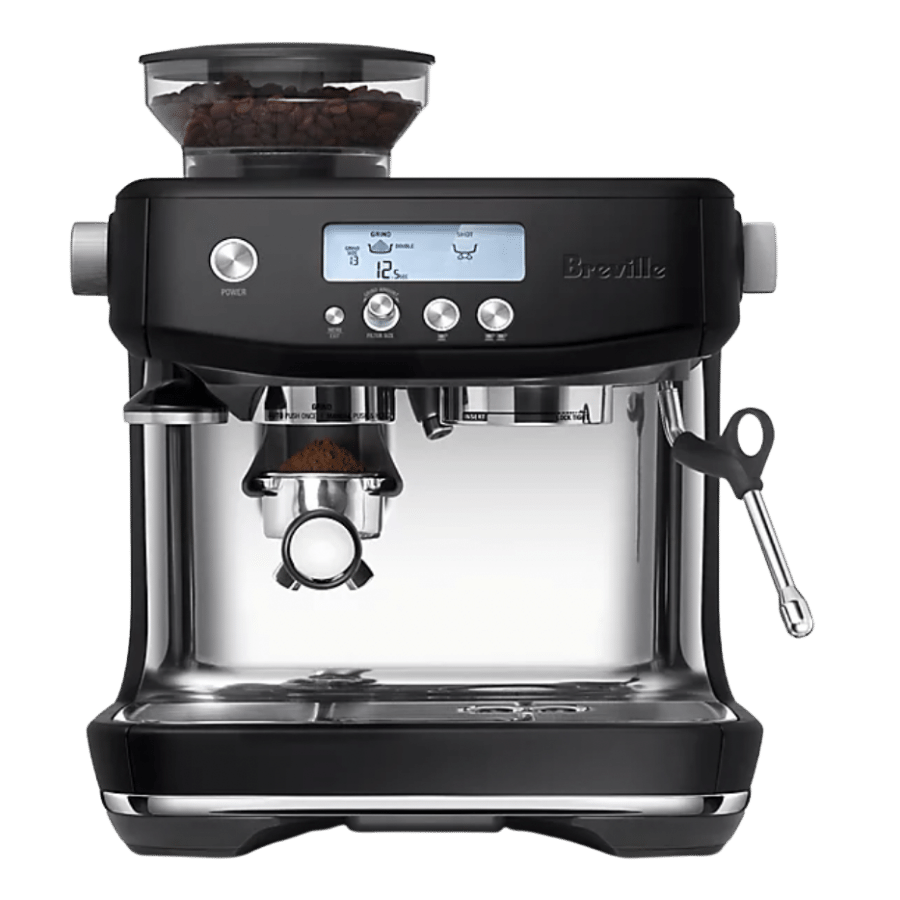
Breville Barista Pro
- Advanced Thermojet heating system
- 30 grind settings
- Four-hole steam wand for higher pressure
The Barista Express espresso machine has an older heating system and milk wand design. The Pro reaches perfect brewing temperature more quickly and keeps temperature control at the forefront of everything the espresso machine does.
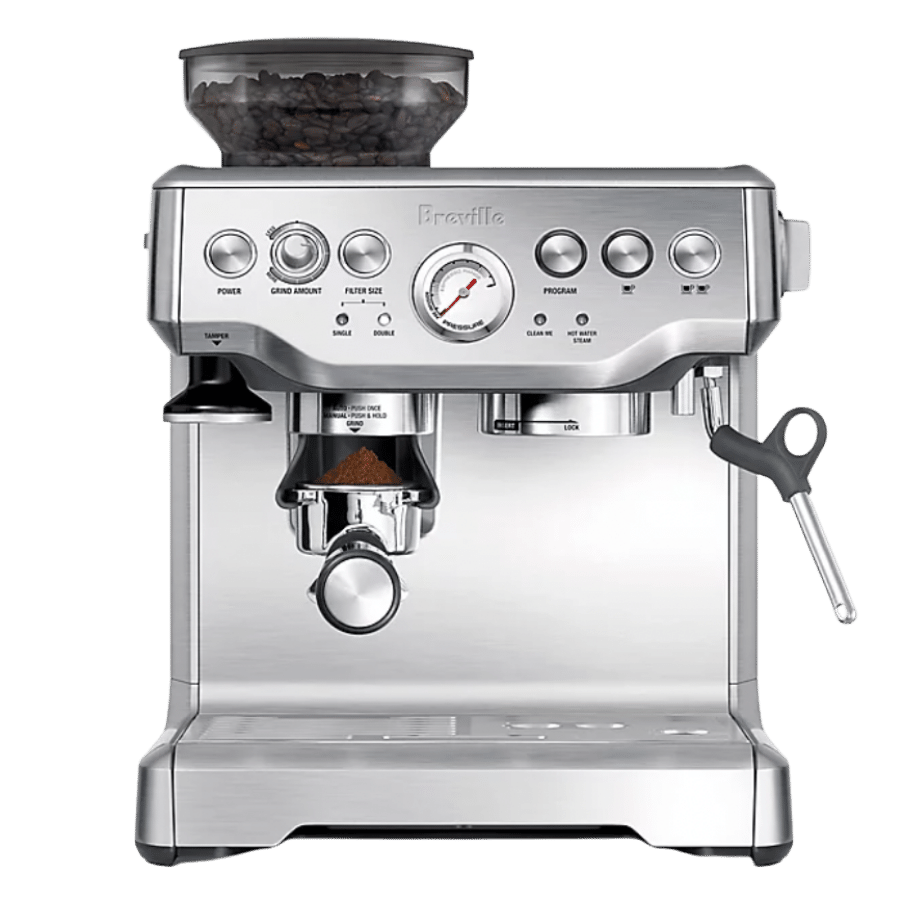
Breville Barista Express
- Thermocoil heating system
- Analog pressure gauge
- 16 grind settings
You can compare the newer version of this model with the Breville Barista Express IMPRESS vs Barista Pro article. Updates to the Impress make it more comparable and easier to use than the Pro (although we still favor the Pro).
Looking For More Machine Options?
If you’re interested in a broader range of machines, see our list of espresso machines for beginners. Looking for a lower-priced espresso machine? See our head-to-head comparison of the Breville Bambino vs Bambino Plus or options under $500.
If you want a full list of semi-automatic espresso machine guides and info articles, see our main espresso page.
Frequently Asked Questions
What’s the difference between the Breville Barista Pro and Express?
The Breville Barista Pro has a digital LCD screen and a more advanced ThermoJet heating system. The Breville Barista Express espresso machine uses an analog display, steam gauge, and thermocoil heating system and costs less than Pro.
Which is better: the Barista Pro or Barista Express?
The Barista Pro is the better machine. The ThermoJet system, more grind size options, and LCD display make better espresso and is easier to use than the Barista Express.
Is the Breville Barista Pro worth the price?
The Pro is well worth the price for Breville’s best heating system, better milk steaming, and ease of use. The Barista Pro’s ThermoJet system makes excellent espresso and is easy to use at a reasonable price.


